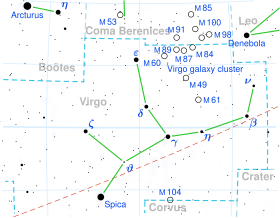오미크론 버진리스
Omicron Virginis| 관측 데이터 신기루 J2000.0 이쿼녹스 J2000.0 | |
|---|---|
| 별자리 | 처녀자리 |
| 우측 상승 | 12h 05m 12.54049s[1] |
| 탈위임 | +08° 43′ 58.7498″[1] |
| 겉보기 크기 (V) | 4.12[2] |
| 특성. | |
| 스펙트럼형 | G8 IIIa CN-1Ba1CH1[3] |
| 아스트로메트리 | |
| 방사 속도 (Rv) | -29.62km[4]/s |
| 고유 운동 (μ) | RA: −218.69[1]mas/yr Dec.: +57.76[1]mas/yr |
| 시차 (π) | 19.98 ± 0.22[1] 마스 |
| 거리 | 163 ± 2 리 (50.1 ± 0.6 pc) |
| 절대치수 (MV) | +0.52[5] |
| 세부사항[4] | |
| 미사 | 2.17 M☉ |
| 반지름 | 9.62 R☉ |
| 루미너스, | 57 L☉ |
| 표면 중력 (log g) | 3.17 cgs |
| 온도 | 5,107 K |
| 금속성 [Fe/H] | -0.30 덱스 |
| 회전 속도 (v sin i) | 2.23km/s |
| 나이 | 0.88 Gyr |
| 기타 지정 | |
| 데이터베이스 참조 | |
| 심바드 | 자료 |
오미크론 버진리스(Omicron Virginis, ο Virginis)는 처녀자리 별자리의 별이다.육안으로 볼 수 있는 시각적 크기는 +4.12이다.[5]시차 측정에 근거해 태양으로부터 약 163광년 떨어져 있다.
ο 버진리스(Virginis)는 G8 IIIa CN-1Ba1CH1의 별 분류를 가진 G형 거성이다.[3]이것은 바륨 별이라는 것을 나타낸다.전형적으로 바륨별은 백색 왜성 동반자를 가진 가까운 이진법이지만, ο 버진리스에게는 어떤 동반자도 검출되지 않았다.[6]과도한 SiIV 방출 유량은 보이지 않는 백색 왜성 동반자 때문이라고 제안되었다.[7]
ο 버진리스(Virginis)는 태양보다 10배 정도 큰 거대한 별이다.약간 서늘하긴 하지만 태양의 60~132배 정도의 광도를 발산하고 있다.이것은 태양보다 두 배 이상 크고 약 10억년 된 것이다.[5][4]단순화된 통계분석 결과 suggests 버진리스가 불활성 헬륨코어 주변의 껍질에 수소를 융합한 적색거성 가지별일 가능성이 높지만, 중심부에 헬륨을 융합한 수평가지별일 확률은 약 22%에 이른다.[8]
참조
- ^ a b c d e van Leeuwen, F. (2007), "Validation of the new Hipparcos reduction", Astronomy and Astrophysics, 474 (2): 653–664, arXiv:0708.1752, Bibcode:2007A&A...474..653V, doi:10.1051/0004-6361:20078357, S2CID 18759600.
- ^ Mallik, Sushma V. (December 1999), "Lithium abundance and mass", Astronomy and Astrophysics, 352: 495–507, Bibcode:1999A&A...352..495M.
- ^ a b Keenan, Philip C.; McNeil, Raymond C. (1989), "The Perkins catalog of revised MK types for the cooler stars", Astrophysical Journal Supplement Series, 71: 245, Bibcode:1989ApJS...71..245K, doi:10.1086/191373.
- ^ a b c Jofré, E.; Petrucci, R.; Saffe, C.; Saker, L.; de la Villarmois, E. Artur; Chavero, C.; Gómez, M.; Mauas, P. J. D. (2015). "Stellar parameters and chemical abundances of 223 evolved stars with and without planets". Astronomy & Astrophysics. 574: A50. arXiv:1410.6422. Bibcode:2015A&A...574A..50J. doi:10.1051/0004-6361/201424474. S2CID 53666931.
- ^ a b c Takeda, Yoichi; et al. (August 2008), "Stellar Parameters and Elemental Abundances of Late-G Giants", Publications of the Astronomical Society of Japan, 60 (4): 781–802, arXiv:0805.2434, Bibcode:2008PASJ...60..781T, doi:10.1093/pasj/60.4.781.
- ^ Začs, Laimons (2000). "The Chemical Composition and Orbital Parameters of Barium Stars". The Carbon Star Phenomenon. 177: 277–284. Bibcode:2000IAUS..177..277Z. doi:10.1017/s0074180900002503.
- ^ Böhm-Vitense, Erika; Carpenter, Kenneth; Robinson, Richard; Ake, Tom; Brown, Jeffery (2000). "Do All BA II Stars Have White Dwarf Companions?". The Astrophysical Journal. 533 (2): 969. Bibcode:2000ApJ...533..969B. doi:10.1086/308678.
- ^ Reffert, Sabine; Bergmann, Christoph; Quirrenbach, Andreas; Trifonov, Trifon; Künstler, Andreas (2015). "Precise radial velocities of giant stars. VII. Occurrence rate of giant extrasolar planets as a function of mass and metallicity". Astronomy & Astrophysics. 574: A116. arXiv:1412.4634. Bibcode:2015A&A...574A.116R. doi:10.1051/0004-6361/201322360. hdl:10722/215277. S2CID 59334290.


